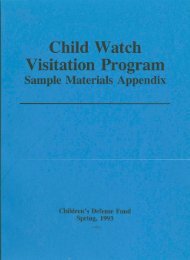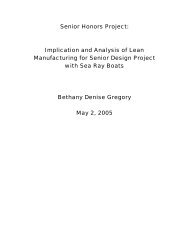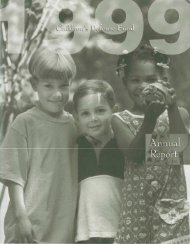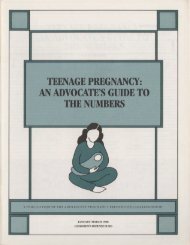child care - Digital Library Collections
child care - Digital Library Collections
child care - Digital Library Collections
Create successful ePaper yourself
Turn your PDF publications into a flip-book with our unique Google optimized e-Paper software.
THE STATE OF AMERICA'S CHILDREN YEARBOOK 1998<br />
Box 6.1<br />
Chll"re....... the Medl.<br />
Children today are exposed to alarming amounts ofviolence and other inappropriate material in<br />
television, movies, and popular music. They are also vulnerable to exploitation on the Internet.<br />
While the mass media and computers can be marvelous tools for education and enjoyment,<br />
they can also pose dangers to <strong>child</strong>ren.<br />
Children and television violence. Two major developments in 1997 could herald better-quality,<br />
less violent television for families-but only if parents hold the television industry accountable.<br />
First, voluntary TV ratings that debuted in October provide both an on-screen age-advisory and<br />
information about program content. A TV-Y7-FV rating, for example, indicates fantasy violence in<br />
<strong>child</strong>ren's programming and recommends that viewers be at least 7 years old, and a TV-I4-V<br />
denotes violence in general programming suitable for an audience over 14. The content information<br />
was added only after sustained pressure from parents and <strong>child</strong> and family advocates.<br />
Advocates demanded the use of the V and FV codes, in particular, because of the hundreds of<br />
studies that link the viewing of violence to increased aggression, heightened fear, and reduced<br />
sympathy for others' pain and suffering.<br />
Despite this step forward, questions remain. Will all networks use the new ratings? (NBC and<br />
BET still do not.) Will objective criteria be developed to help networks apply the same standards<br />
in rating similar programs? Will parents use the rating system-and the V-ehip, expected in TV sets<br />
sold in 1998 and later-to turn off violent and otherwise objectionable content? Advocates will<br />
keep monitoring the implementation of the new ratings and will work with parents and the<br />
industry to fine-tune them to meet families' needs.<br />
A second development was the September 1 launch of the Ell rating, indicating educational<br />
or informative programs for <strong>child</strong>ren, and the new Federal Communications Commission (FCC)<br />
requirement that stations air at least three hours per week of such programs. It is hoped that<br />
stations will respond with better (including nonviolent and noncommercial) shows for <strong>child</strong>ren,<br />
and that families will eagerly and easily find them. The fall 1997 season contained some promising<br />
programming, and with positive feedback from parents and continued FCC oversight, improvement<br />
may be ongoing.<br />
Children's safety on-line. The fust summit on <strong>child</strong>ren and the Internet was held in December<br />
1997, bringing together political leaders, industry executives, and <strong>child</strong> and family advocates. The<br />
summit focused on safety, particularly <strong>child</strong>ren coming into contact with pedophiles and pornography<br />
on the Internet. Participants discussed some of the potential protections that are emerging:<br />
filters available from software or Internet service providers, ratings of sites, and selected sites set<br />
aside for <strong>child</strong>ren. Many who want to safeguard <strong>child</strong>ren see such tools as an important supplement<br />
to legislative regulation-especially given that the Supreme Court struck down, on First<br />
Amendment grounds, tbe indecency provisions in the Communications Decency Act of 1995.<br />
Pressure remains on the public and private sectors to develop solutions that keep <strong>child</strong>ren safe<br />
in cyberspace. Future Internet summits will focus on other critical issues, including universal<br />
access for all <strong>child</strong>ren, good content for <strong>child</strong>ren, privacy concerns, and on-line commercial<br />
marketing to <strong>child</strong>ren. Families can fmd information about Web sites for <strong>child</strong>ren and parents<br />
through tbe Parent's Resource Network on CDF's home page: www.<strong>child</strong>rensdefense.org.<br />
80 CHI L D R EN'S D E F ESE FUN D














